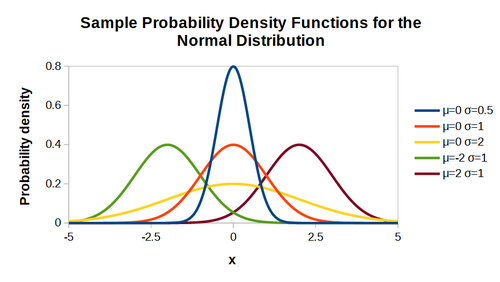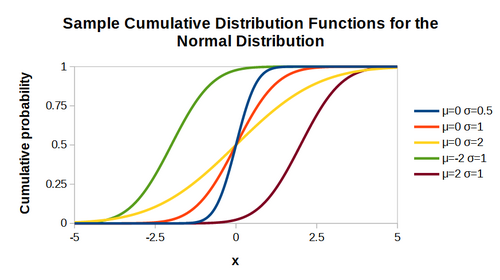Documentation/Calc Functions/NORM.DIST
TDF LibreOffice Document Liberation Project Community Blogs Weblate Nextcloud Redmine Ask LibreOffice Donate
Function name:
NORM.DIST
Category:
Statistical Analysis
Summary:
Calculates normal distribution values from either the probability density function or the cumulative distribution function.
The normal distribution is also known as the Gaussian distribution. It is a family of continuous probability distributions used in many fields to represent independent, randomly generated variables. Each normal distribution has a curve with the same general bell shape that is symmetric about the mean (often denoted by the lowercase Greek letter mu (μ)), with a spread defined by the standard deviation (often denoted by the lowercase Greek letter sigma (σ)).
Syntax:
NORM.DIST(Number; Mean; STDEV; C)
Returns:
Returns a non-negative real number, which is the normal distribution value for the given arguments. For the probability density function, the value returned lies in the range [0, +∞). For the cumulative distribution function, the value returned lies in the range [0, 1].
Arguments:
Number is a real number, or a reference to a cell containing that number, which is the value at which the normal distribution is to be evaluated.
Mean is a real number, or a reference to a cell containing that number, which is the mean of the normal distribution.
STDEV is a positive real number, or a reference to a cell containing that number, which is the standard deviation of the normal distribution.
C is a logical value, or a reference to a cell containing that value, that determines whether the required probability is taken from the probability density function or the cumulative distribution function. If C is set to 0 or FALSE, a value from the probability density function is calculated. For any other values of C, a value from the cumulative distribution function is calculated.
- If any of Number, Mean, or STDEV is non-numeric, then NORM.DIST reports a #VALUE! error.
- If STDEV is less than or equal to 0.0, then NORM.DIST reports an invalid argument error (Err:502).
Additional details:
- Calc's NORMDIST and NORM.DIST functions perform similar calculations. However, there are minor differences between the two functions with respect to their arguments – for NORMDIST the C argument may be omitted. The requirements for NORMDIST are specified in ODF 1.2; NORM.DIST is provided for interoperability with Microsoft Excel.
- The normal distribution with a mean of 0 and standard deviation of 1 is known as the standard normal distribution. This gives rise to the following relationships between relevant Calc functions:
- [math]\displaystyle{ \text{NORM.DIST}(x;\:0;\:1;\:c)\:=\:\text{NORM.S.DIST}(x;\:c)\:=\:\text{NORMSDIST}(x) }[/math]
- and
- [math]\displaystyle{ \text{NORM.DIST}(x;\:0;\:1;\:0)\:=\:\text{NORM.S.DIST}(x;\:0)\:=\:\text{PHI}(x) }[/math]
- The formula for the probability density function of the normal distribution is:
- [math]\displaystyle{ PDF_{normal}(x; \mu; \sigma)~=~\frac{1}{\sigma\sqrt{2\pi}}~\text{EXP} \left(-\frac{1}{2}\left( \frac{x-\mu}{\sigma} \right)^2 \right) }[/math]
- The formula for the cumulative distribution function of the normal distribution is:
- [math]\displaystyle{ CDF_{normal}(x; \mu; \sigma)~=~\int_{-\infty }^{x}\frac{1}{\sigma\sqrt{2\pi}}~\text{EXP} \left(-\frac{1}{2}\left( \frac{t-\mu}{\sigma} \right)^2 \right) \:dt }[/math]
- The following figure shows probability density function plots for five sample normal distributions.
- The following figure shows cumulative distribution function plots for five sample normal distributions.
- The name space for NORM.DIST is
COM.MICROSOFT.NORM.DIST. - For more information on the normal distribution, visit Wikipedia's Normal distribution page.
Examples:
| Formula | Description | Returns |
|---|---|---|
| =NORM.DIST(A1; A2; A3; A4) where cells A1:A4 contain the numbers 7.14, 1.5, 3.2, and 1 respectively. | Here the function calculates a value from the cumulative distribution function of the normal distribution for the given argument values. | 0.961007571808867 |
| =NORM.DIST(7.14; 1.5; 3.2; FALSE()) | Here the function calculates a value from the probability density function of the normal distribution for the given argument values. | 0.026376219058927 |
| =NORM.DIST(2; 0; 0.5; 0) | Here the function calculates a value from the probability density function of the normal distribution for the given argument values. Note that the normal distribution is symmetric and so the formula =NORM.DIST(-2; 0; 0.5; 0) returns the same value. |
0.000267660451529771 |
| =NORM.DIST(1; 0; 1.2; 1) | Here the function calculates a value from the cumulative distribution function of the normal distribution for the given argument values. Note that the normal distribution is symmetric and so the formula =1-NORM.DIST(-1; 0; 1.2; 1) returns the same value. |
0.797671619036357 |
| =NORM.DIST(0.5; 0; 1; 0) | Here the function calculates a value from the probability density function of the standard normal distribution. Note that the formulas =NORM.S.DIST(0.5; 0) and =PHI(0.5) return the same value. |
0.3520653267643 |
Related LibreOffice functions:
ODF standard:
None
Related (or similar) Excel functions:
NORM.DIST

